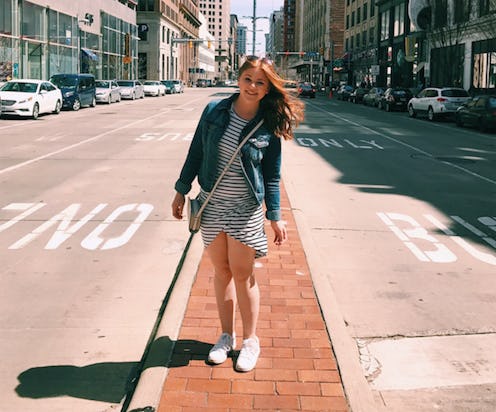Fashion
Why I Started Shopping Secondhand

Sustainable fashion is nothing new — at least not in my life. Even before celebrities popularized the trend, I was saving the world one thrift store find at a time. OK, so that's a little bit of an exaggeration, but I have been trying to make the world a better place. I started shopping almost exclusively at thrift stores this year, and let me tell you, with some time and a little patience, it's easy for you to make your wardrobe matter too. Because what you wear has a bigger effect on the planet than you might think.
I've always been a fan of secondhand clothing. As the oldest child of a family of four and a ten-year age gap between me and my cousins, I never got hand-me-downs, so I stuck to garage sales to get my fix. I've been stopping at these sales with my mom for as long as I can remember. The idea of taking something that was loved by someone else and giving it a new life was instilled in my from a young age, and stuck with me through the years.
When I entered my 20s, my affinity for secondhand shopping grew. I had just graduated from college, landed a job as a fashion and beauty writer, and was living at home with my parents. I needed a way to stay on-trend with my clothing without going broke. That's when I started thrifting in earnest. While I still did a fair amount of online shopping, affordable secondhand items helped me build out my wardrobe. I found that, with a little bit of digging, I could find trendy items for less, which meant it wasn't a huge commitment if I ended up disliking them.
Then the 2016 election happened, and Donald Trump became president. Along with many others, I began to really fear for the future of our Earth. With our new president refusing to acknowledge global warming and threatening to abolish the EPA, I decided that I was going to do something about it. No matter how big or small my contribution was, I would try make my life matter. I decided to go big and commit to a thrifted-only closet.
I've made it my goal to live purposefully in 2017. Mainly, that has meant buying things that are good for my body, my wallet, and the world. Because fashion and beauty purchases get so much of my money, it also meant making some big changes to my purchases. The biggest life change was shopping exclusively at thrift stores. Not only would I save money and give back to charity by shopping at places like Salvation Army and Goodwill, I'd also be helping with the global waste problem.
Upon doing some fashionista research, I found that, according to Forbes, clothing production has been linked to global warming. The publication found that the apparel industry is the second largest industrial polluter — second to oil. Let that sink in for a moment. If our administration wasn't going to acknowledge the cold, hard facts, I would — by changing the way I shopped.
So far in 2017, I've stuck to my goals of purchasing only secondhand clothing, and it's completely changed my wardrobe. I feel better knowing that my purchases aren't contributing to upping the amount of clothing production pollution. I've also been able to try more trends in just four months than in all of 2016 combined, and it doesn't hurt that I've gotten every item for $5 or less.
I'm not the only one who's gotten on board with the benefits of shopping secondhand, either. According to threadUP, apparel resale has had explosive growth in recent years. Their research shows that one out of three women said that they would shop secondhand and the resale industry is at $18 billion, with projected growth to $33 billion in 2021. That's a lot more than you can say about fast fashion trends, which, according to Newsweek, is creating an environmental crisis.
Would you believe me, if I told you this dress was only $1.99? Well, it was! The haltered and striped petal-layered dress looked almost brand new when I picked it up from the thrift store. Not only did I get an on-trend and super comfy dress, but I gave it a new life by wearing it instead of buying something new. That's what thrifting is all about.
If we can cut down on the amount of clothing we buy from department and fast fashion stores, which often contribute to this global crisis by over-producing clothing, we can help assuage global warming. Whether it's using apps like Vinted and thredUP to sell clothing, buying from thrift stores, or shopping at flea markets, every little bit matters. Making the world a better place for future generations is way more important than that crop top you've been eyeing.